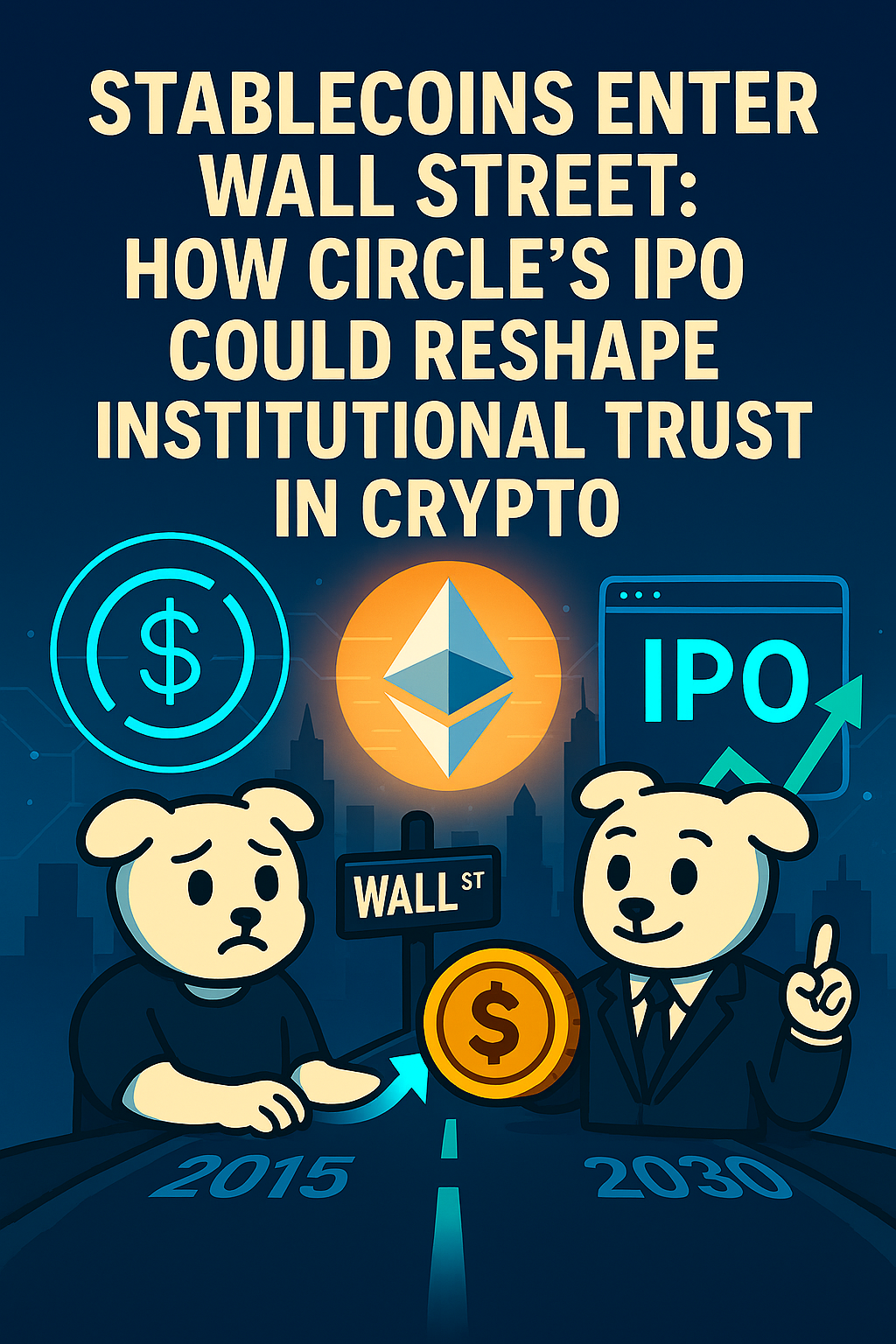Stablecoins Enter Wall Street: How Circle’s IPO Could Reshape Institutional Trust in Crypto

For years, stablecoins have lived in the crypto trenches essential to the ecosystem but rarely seen as glamorous.
They were practical, not flashy. They powered DeFi trades, offered price stability, and served as the bridge between fiat and digital assets.
But now, with Circle preparing for a public listing on the New York Stock Exchange, that narrative is changing and fast.
This isn’t just about another crypto company going public. This is about who is helping them do it.
Circle’s IPO is being backed by traditional finance giants like JPMorgan and Goldman Sachs. That’s a big deal.
Because when legacy institutions start betting on stablecoins, it signals a shift: from niche utility to mainstream financial legitimacy.
The Evolution of Stablecoins
Let’s rewind a bit. Stablecoins like Circle’s USDC were originally created to give crypto traders a way to avoid volatility. They provided the stability of the dollar, without the need to move in and out of bank accounts.
Over time, they evolved used for remittances, cross-border payments, merchant settlements, and more.
Yet, despite their growing utility, stablecoins have long existed in a regulatory gray area.
Skepticism around reserves, transparency, and systemic risk has limited their adoption outside of crypto-native environments.
Institutional players watched from the sidelines, wary of diving in too deep.
Circle’s IPO might finally change that.
Wall Street’s Stamp of Approval
What makes this IPO different isn’t just that a stablecoin issuer is going public. It’s that major Wall Street banks are standing behind it.
When JPMorgan and Goldman Sachs underwrite a listing, they’re not just managing paperwork they’re vouching for the company’s credibility.
For institutions, this level of endorsement matters. It turns Circle from “a crypto company” into a legitimate, regulated financial services firm.
This isn’t just optics. Going public means opening up to shareholder scrutiny, quarterly reports, SEC oversight, and full financial transparency.
For institutions that have hesitated to touch stablecoins due to regulatory uncertainty or risk exposure, this could be the moment of reassurance they’ve been waiting for.
From Crypto Utility to Financial Infrastructure
With stablecoins under the Wall Street spotlight, their role could expand far beyond crypto. Think about the inefficiencies in traditional finance slow cross-border payments, high fees, delayed settlements. Stablecoins offer a faster, cheaper, programmable alternative.
Circle’s public listing could be the catalyst that moves USDC and perhaps others from a crypto-native tool to a global financial instrument.
We’re talking about stablecoins embedded in treasury management systems, corporate payment rails, and even consumer fintech apps.
For big institutions, this isn’t just about using new tech it’s about future-proofing their infrastructure.
• A Path for Others to Follow:
Circle’s IPO also sets a precedent. If successful, it opens the door for other crypto-native companies especially stablecoin issuers like Paxos, or even algorithmic projects (with proper guardrails) to explore public listings.
It also encourages policymakers to take a more nuanced, constructive approach toward regulation.
In a way, Circle’s IPO could serve as the bridge between Web3 and TradFi between blockchain rails and real-world finance.
And in doing so, it may finally answer one of the crypto industry’s longest-running questions: Can stablecoins scale trust beyond the blockchain?
Final Thoughts
The road ahead won’t be without hurdles. Regulatory uncertainty still looms large in the U.S., and the emergence of central bank digital currencies (CBDCs) could create new competition.
There are also questions about systemic risk and whether a private stablecoin should play such a critical role in global payments.
But Circle’s IPO is more than a financial event it’s a cultural moment. It shows that the line between crypto and traditional finance is blurring.
That institutions are no longer content to sit on the sidelines. And that stablecoins, once seen as basic plumbing for DeFi, are stepping into the spotlight.
Wall Street is opening the doors and this time, stablecoins aren’t just visitors. They’re here to stay.
📚 References:
1. Circle’s Official IPO Filing (SEC Form S-1) U.S. Securities and Exchange Commission (SEC) Circle filed to go public via an S-1 registration with the SEC, revealing detailed information about USDC adoption, reserves, and financials. 🔗 https://www.sec.gov/Archives/edgar/data/0001838126/0000000000-23-000000-index.htm
2. JPMorgan and Goldman Sachs Back Circle’s IPO Bloomberg, 2024 The involvement of top-tier underwriters signals growing institutional acceptance of stablecoin infrastructure.
3. USDC Transparency Reports Circle Internet Financial Monthly attestations and reports on USDC reserves, helping build credibility with institutions. 🔗 https://www.circle.com/en/usdc-transparency
4. Stablecoins and the Future of Payments Bank for International Settlements (BIS), 2023 A global review of stablecoins, their risks, and use cases in mainstream finance.
Comments ()